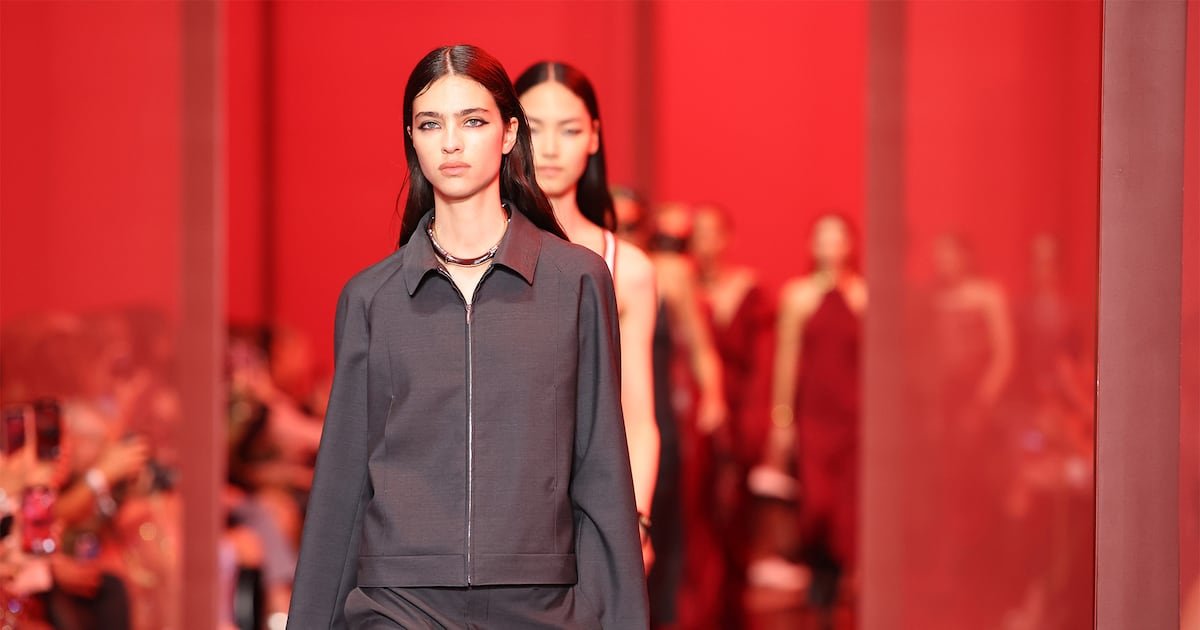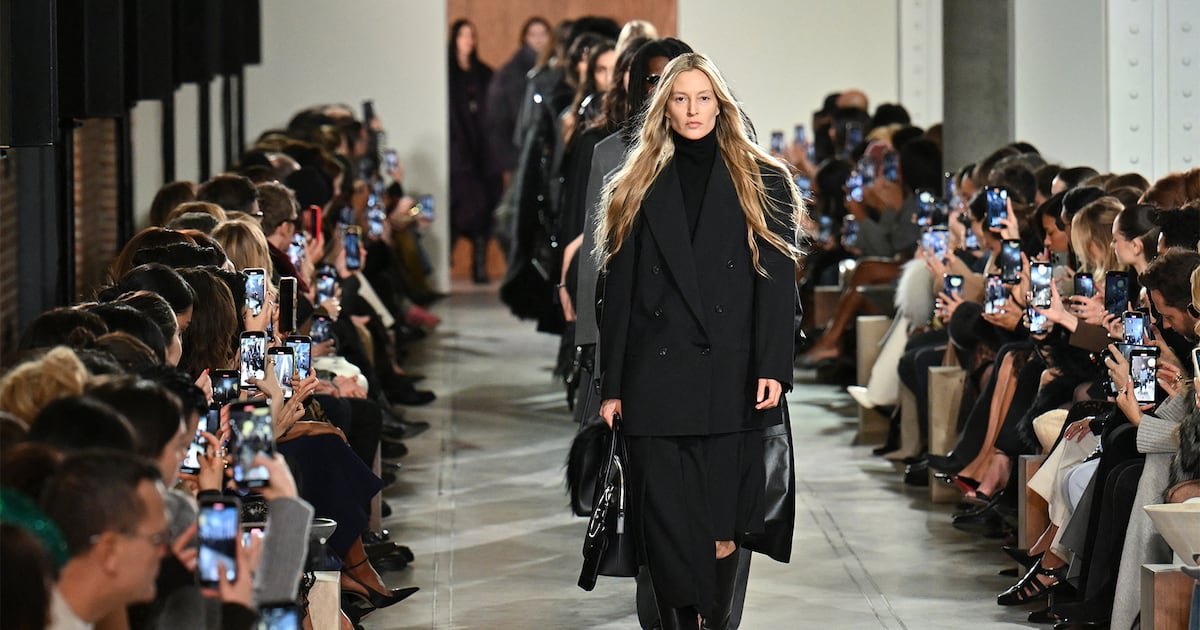
PARIS — Gucci’s sales plunged 24 percent in the fourth-quarter, underscoring the steep decline that prompted the brand to seek a new creative direction. After ousting designer Sabato De Sarno last week, owner Kering is under pressure to name a replacement.
Kering’s overall sales fell 12 percent in the quarter, with the decline at Gucci partly offset by an acceleration at stablemate Bottega Veneta. The high-end brand known for its logo-free, intrecciato bags grew 12 percent.
Sales continued to decline at Saint Laurent (down 8 percent) and the “Other Brands” division which houses Balenciaga and McQueen (down 4 percent), though these drops were less dramatic than during the previous quarter.
Operating profit fell 46 percent to €2.6 billion, slightly above analyst expectations.
Kering has been hit hard by a global slowdown in luxury demand, which came at the same time as its effort to reposition Gucci’s strategy and aesthetic with a more upscale, timeless focus.
Consumer sentiment in China, previously the growth engine of luxury demand, remains depressed, while a more resilient US market remains short on less-wealthy, “aspirational” clients. The group plans to close 50 stores in 2025 to adapt to the slower market, co-deputy CEO Jean-Marc Duplaix said.
The value of the group’s shares has fallen by 40 percent over the past year. “This was an ‘annus horribilis’ for Kering, that much is reflected in the share price,” Bernstein analyst Luca Solca wrote in a note to clients.
In a presentation to investors, the group insisted its turnaround efforts were on track, despite the continued decline in sales.
“The transition phase is over. We’ve hit an inflection point where now we’re ready to get started again. But of course this is subject to the economic environment — so we’re forecasting a year of stabilisation,” chairman and CEO François-Henri Pinault said. “We remain prudent about 2025.”
Performance in the first weeks of 2025 remains broadly in line with the fourth-quarter, Kering said.
Gucci’s ‘Fashion Authority’
At Gucci, “the goal was to give a very solid foundation; to [limit] a little bit the ups and downs,” co-deputy CEO Francesca Bellettini said. Working with De Sarno, Gucci “focused on the heritage of the brand and trying to elevate our products, to make them consistent with the heritage, but at the same time relevant today.”
The brand has worked to cut its exposure to outlets and wholesalers, notably online, while investing in a more responsive supply chain. It brought on Stefano Cantino, a veteran operator from Prada and Louis Vuitton, as its new CEO last year.
“The base we have today is much stronger than what we had 18 months or two years ago, and now it’s a perfect moment to inject a new creativity,” Bellettini added.
A new Gucci designer will be announced “promptly, sooner rather than later,” with plans to adopt a “50-50 split between tradition and fashion authority,” she said.
“We’re not entering a new transition phase,” Pinault insisted. “The arrival of a new designer won’t slow down the recovery of the brand.”
Reigniting excitement and demand for Gucci is primordial for the group: the brand, Italy’s biggest fashion house, accounts for half of Kering’s sales and two-thirds of profit.
Bottega Veneta’s Shakeup
Bottega Veneta was the group’s main bright spot, with sales accelerating in the fourth quarter.
The brand has kept up with the luxury market’s shift to wealthier clients, who are less exposed to macro-economic shocks. In the last year, it has opened an invitation-only store in a Venetian palazzo, as well as other new flagships with a concept Bellettini described as “stunning, sophisticated and at the same time inviting.” The brand has also launched a line of candles and fragrances “which create brand relevance at a lower price point without compromising on its ultra high-end positioning,” she said.
The trouble is, its star creative director Matthieu Blazy has decamped to Chanel. That means the brand will have to navigate its third creative transition in a decade. New designer Louise Trotter, formerly the creative director of Carven and Lacoste, “is a very natural fit for the brand, a perfect choice to perpetuate Bottega’s values and aesthetic,” Bellettini said. “She has the right credentials to create fidelity in ready-to-wear, similarly to what the brand has already achieved in leather goods.”
Saint Laurent, Balenciaga
In November, former Balenciaga CEO Cedric Charbit took the reins at Saint Laurent in order to allow Bellettini, the brand’s former chief, to focus on her group-level role as deputy CEO. He’s been succeeded at Balenciaga by Gianfranco Gianangeli, formerly CEO of OTB’s Maison Margiela.
Under new management, Saint Laurent and Balenciaga will focus on boosting the store productivity through savvy retail practices and updated merchandising, rather than embarking on any major strategic or creative overhauls. “Evolution can be extremely powerful,” Bellettini said. “Don’t expect big shifts or big turnarounds, but a strong evolution on a very strong base.”
Market Reaction
Kering’s sales were hotly watched as investors look for signs that the luxury market is turning a corner. In January, Richemont reported a return to double-digit growth, while LVMH’s fashion sales fell at a slower rate than the previous quarter, leading to cautious optimism.
But investors are wary of continued macro-economic headwinds, as well as specific obstacles to Kering’s turnaround. Gucci’s new designer will need to revive fashion excitement in a rocky market, at a brand where the work of upscaling its product offer, supply chain and distribution still isn’t complete (The brand is headed for another round of cuts to its outlet and wholesale exposure this year).
The company’s share price fell 1 percent on the Paris bourse despite the group beating expectations for profit. “This confirms our view that better trends in the sector are limited to a few names only,” UBS analyst Zuzanna Pusz said.
Other observers were more optimistic. “The relative performance gap [between Gucci and competitors] has not yet closed, however with new CEO Stefano Cantino apparently willing to make bold changes, including changing creative director, we believe the worst may be behind us,” RBC Capital Markets analyst Piral Dadhania said.
Market Reaction
Kering’s sales were hotly watched as investors look for signs that the luxury market is turning a corner. In January, Richemont reported a return to double-digit growth, while LVMH’s fashion sales fell at a slower rate than the previous quarter, leading to cautious optimism.
But investors are wary of continued macro-economic headwinds, as well as specific obstacles to Kering’s turnaround. Gucci’s new designer will need to revive fashion excitement in a rocky market, at a brand where the work of upscaling its product offer, supply chain and distribution still isn’t complete (The brand is headed for another round of cuts to its outlet and wholesale exposure this year).
The company’s share price fell 1 percent on the Paris bourse despite the group beating expectations for profit. “This confirms our view that better trends in the sector are limited to a few names only,” UBS analyst Zuzanna Pusz said.
Other observers were more optimistic. “The relative performance gap [between Gucci and competitors] has not yet closed, however with new CEO Stefano Cantino apparently willing to make bold changes, including changing creative director, we believe the worst may be behind us,” RBC Capital Markets analyst Piral Dadhania said.



